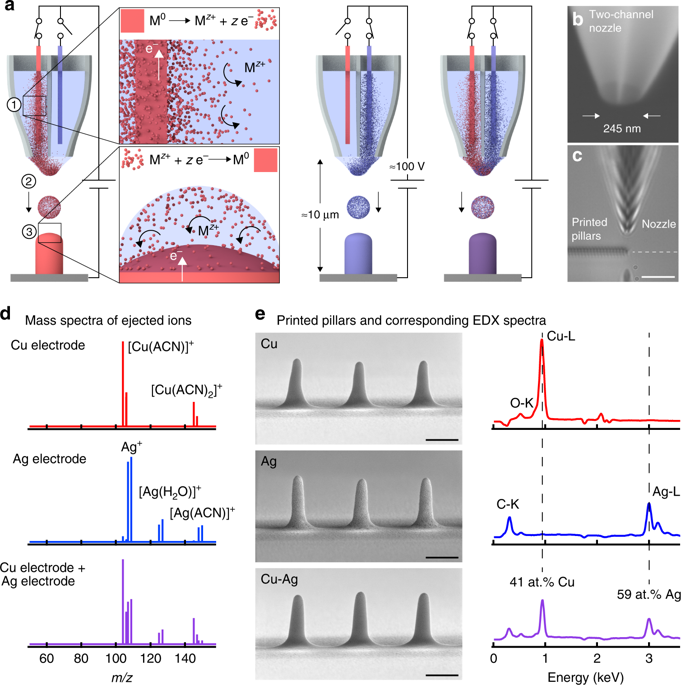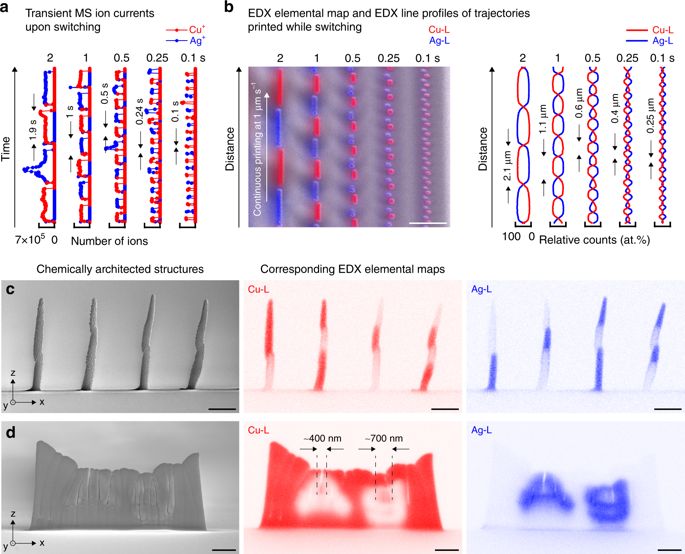Researchers from Switzerland explain more about how metals dissolved and re-deposited in liquid solvents can further AM processes by promoting fabrication without post-processing. Their findings are outlined in the recently published, ‘Multi-metal electrohydrodynamic redox 3D printing at the submicron scale.’ This new method allows users to create polycrystalline multi-metal 3D structures from a single nozzle with multiple channels.
The authors point out that additive manufacturing on the microscale is very popular, and especially with expanded capabilities in relation to materials. Users want more—and especially on the industrial level; realistically though, challenges still abound:
“…first, common multi-nozzle approaches enforce extensive practical limits to the complexity of the 3D chemical architecture; second, as-deposited properties of inorganic materials, mostly dispensed as nanoparticle inks, are often far from those demanded in microfabrication, and the hence required post-print processing largely complicates many materials combination,” state the researchers.
The ink-free electrohydrodynamic redox printing (EHD-RP) eliminates these issues in metal, with direct printing and combination of materials from one nozzle. The authors say that their new method offers ‘unmatched control of the 3D chemical architecture of printed structures.’ Many different metals can be used in EHD-RP, with both direct and indirect printing possible.

Electrohydrodynamic redox printing (EHD-RP). a Working principle: (1) Solvated metal ions Mz+ are generated within the printing nozzle via electrocorrosion of a metal electrode M0 immersed in a liquid solvent. (2) Ion-loaded solvent droplets are ejected by electrohydrodynamic forces. (3) Upon landing, Mz+ ions are reduced to zero valence metal M0 through electron transfer from the substrate. Switching the oxidative voltage between different electrodes in a multichannel nozzle enables on-the-fly modulation of the printed chemistry (Schematics not drawn to scale: typical dimensions of the electrode wire are 100 μm × 2 cm). b Typical two-channel nozzle. c Optical micrograph of the printing process. Scale bar: 10 μm. d, e Printing Cu, Ag and Cu–Ag from a single, two-channel nozzle. d Mass spectra of ejected ions when biasing the Cu electrode, the Ag electrode, or both electrodes immersed in acetonitrile (ACN). e Printed Cu, Ag and Cu–Ag pillars with corresponding energy-dispersive X-ray (EDX) spectra reflecting the chemical nature of the respective source electrode (background subtracted). The C–K and O–K peaks likely originate from residual solvent and minor oxidation, respectively. The Cu and Ag contents of the Cu–Ag pillars are given in at.% normalised to the total Cu + Ag signal. Scale bars: 500 nm.
The authors mention that while there is very little lateral misalignment during switching, there has been some indication of minor shifting between the two metals. The authors state that this is usually caused because of the nozzle’s asymmetry. Complexity in geometry and fidelity are not as high as the authors would like either, but they state that this is a common issue in EHD-based microprinting techniques.

Geometrical performance and as-printed microstructure. a Array of 50 × 50 Cu pillars printed with a point-to-point spacing of 500 nm. Scale bar: 5 μm. b Walls printed at decreasing wall-to-wall spacing, with a minimum spacing of 250 nm. Height: ten layers for the leftmost image, three layers for the others. Scale bars: 1 μm. c Printed Cu line less than 100 nm in width. d Cu wire with an aspect ratio of approximately 400. e Overhangs formed by a lateral translation of the stage balancing the out-of-plane growth rate. The sequence of pillars was printed by increasing the respective in-plane translation speed towards the front pillar, with a maximum speed of 2.1 μm s−1. Scale bar: 1 μm. f Concentric, out-of-plane sine waves printed with a layer-by-layer strategy. Scale bar: 2 μm. g As-printed Cu pillar and corresponding cross-section showing the dense, polycrystalline microstructure. Scale bars: 200 nm
This process also improves mechanical and electrical properties, allowing for potential in applications for manufacturing sensors or actuators, optical metamaterials, and small-scale wire bonding. For this study, the researchers only used three metals, but that number could be increased with the use of nozzles bearing additional channels.
“Thus, EHD-RP holds the potential for unlocking unique routes for the bottom-up fabrication of chemically designed 3D devices and materials with locally tuned properties and a rational use of alloying elements. Such materials could find application in catalysis, active chemical devices, small-scale robotics and architected materials that go beyond single-material cellular designs,” concluded the researchers.
While you may look at a term like electrohydrodynamic redox 3D printing and think things are really getting out there now, the idea behind the process is very simple, but two-fold: to both refine 3D printing and additive manufacturing further—and cutting out the much-dreaded post processing processes still prevalent. Researchers have been working on this issue continually, from creating post-processing hardware, to eliminating post processing from color 3D printing to providing automation for dental printers.
Find out more about electrohydrodynamic redox 3D printing here. What do you think of this news? Let us know your thoughts! Join the discussion of this and other 3D printing topics at 3DPrintBoard.com.

Additive control of the chemical architecture with a single nozzle. a, b Fast switching between two metals printed from a two-channel nozzle. a Summed mass spectrometry (MS) ion currents of Cu+ (red) and Ag+ (blue) cations ejected upon switching the anodic voltage between a Cu and a Ag electrode at different intervals. Switching between two ejected ion species is highly selective. b Overlaid SE micrograph and EDX elemental map of trajectories printed with the same switching profile as in (a) (Cu-L signal, red, and Ag-L signal, blue). The corresponding EDX line profiles show that the switching between Cu and Ag is resolved up to the smallest pulse width. Scale bar: 2 μm. c, d Examples of chemically heterogeneous structures printed using a single nozzle. c Sequence of pillars with different numbers of Cu and Ag modulation periods. Scale bars: 1 μm. d Out-of-plane Cu wall with the letters ‘Ag’ embedded in silver, printed with a continuous layer-by-layer printing mode
[Source / Images: ‘Multi-metal electrohydrodynamic redox 3D printing at the submicron scale’]

187 Replies to “Switzerland: Exciting New Technology Multi-Metal Electrohydrodynamic Redox 3D Printing”
Comments are closed.